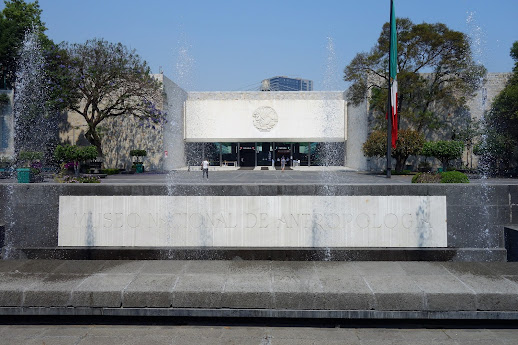Mexico City's greatest museum, and one of the great museums of the world, is the National Museum of Anthropology in Chapultepec Park. During the recent surge in COVID cases the museum was once again closed. However, shortly after my arrival it reopened, and I paid another visit last week.
The museum is renowned for its incomparable collection of artifacts from the pre-Hispanic civilizations of Mexico.
However, most visitors never make it the upper floor which contains ethnographic exhibits on the native peoples who inhabit Mexico to this day. If you have a super-memory, you may recall that in January of 2020 I went upstairs and found that a complete renovation of the floor was underway. It was my intention to visit one or two of the galleries on each visit and write about them on the blog. I wrote an entry about the Huichol tribe of western Mexico who are famous for their impressive pieces of art decorated in beads and their "paintings" made of yard glued to wooden boards.
The renovation of the upstairs is still not complete, but I visited a couple more galleries. First was the exhibit devoted to the Purépecha people, also known as the Tarascans. Since pre-Hispanic times they have lived in the region that is today the Mexican state of Michoacán. Before the arrival of the Spanish, they had maintained their independence from their enemies, the Aztecs, and had created the second largest empire of Mesoamerica. Today there are around 200,000 people who still speak the Purépecha language.
The Purépechas are known for a wide variety of handicrafts.
Even in pre-Hispanic times the Purépechas were known as metalworkers. Today the town of Santa Clara del Cobre produces handmade copperware.
In pre-Hispanic times the Purépecha were famous for the now nearly lost art of creating pictures from feathers. This picture from the early 1800s depicting the Mexican coat of arms is done entirely in feathers.
Of the many folkloric dances of the Purépecha, the best known is the dance of the "viejitos"... the little old men... in which the dancers wear masks and carry canes. It originated as a ceremony to ask "The Old God" for a successful harvest, and then after the Spanish conquest evolved into a parody of old white men.
In an outdoor exhibit, there is an traditional "troje", a Purépecha house built of pine wood. These buildings have nearly disappeared, and this "troje", which was built in the early 1800s, was disassembled and brought to the museum. This one is notable for its fine carvings on the columns and door.
Still to come in a future entry, is the museum gallery on the Otomí people of central Mexico.


















the Mexican state of Michoacán-my ancestors were from there and I really appreciate the pictures and notes you have on their culture and artifacts. Very interesting!
ReplyDeleteGlad that it was of personal interest to you. Michoacán is one part of Mexico that I have not visited (other than Tlalpujahua which is just across the border). I really want to go there someday. Morelia and Pátzcuaro and nearby towns sound fascinating.
DeleteI'm happy that you were able to see one of your favorite places and mine. You didn't happen to see the sunglasses I lost there, did you?
ReplyDeleteHa! ha! No, I didn't.
Delete